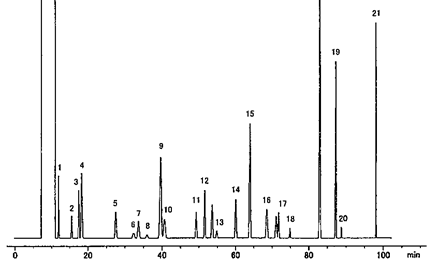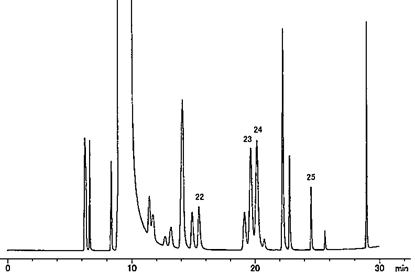VOC and Stinking Substances Analysis
Volatile Organic Compounds (VOCs) are organic chemicals that have a high vapor pressure at ordinary room temperature. VOCs are widely used because they are important substances as solvents and fuels. However, when released into the environment, these cause health hazards such as pollution. So VOCs are regulated by law in some countries. FUJIFILM Wako provides 4 types of VOC mixture standard solutions. Especially, 25 VOC mixture standard solution is traceable to SI traceable Japanese measurement standards (Japan Calibration Service System; JCSS).
Stinking substances cause unpleasant odors and may damage the living environment. In Japan, 22 stinking substances have been designated by the Environment Agency, and all factories within the regulated area designated by the each local government are required to measure stinking substances to considerate of the surrounding environment.
FUJIFILM Wako provides a variety of standard solution and columns to analyze stinking substances.
GC Analysis (25 VOC Mixture Standard Solution)
GC Chromatogram
Analytical Conditions
-
Column DB-624 3.0μm 0.53mm×75m Column
temperature30℃(40min)→2℃/min→50℃→5℃/min→60℃(18min)→
5℃/min→90℃(10min)→5℃/min→150℃(4min)Sample 2μL Carrier gas He 4.9mL/min Injection cool on-column Detector FID, 250℃ Instrument Agilent 7890B -
Column DB-WAX 1.0μm 0.53mm×60m Column
temperature40℃(2min)→20℃/min→80℃(16min)
→10℃/min→180℃Sample 2μL Carrier gas He 2.9mL/min (20min) → 4.6mL/min (Flow rate : 1.0mL/min) Injection cool on-column Detector FID, 230℃ Instrument Agilent 7890B
| Peak No. | Constituent | Peak No. | Constituent | Peak No. | Constituent |
|---|---|---|---|---|---|
| 1 | 1,1-Dichloroethylene | 10 | 1,2-Dichloroethane | 19 | o-Xylene |
| 2 | Dichloromethane | 11 | Trichloroethylene | 20 | Bromoform |
| 3 | trans-1,2-Dichloroethylene | 12 | 1,2-Dichloropropane | 21 | p-Dichlorobenzene |
| 4 | t-Butyl Methyl Ether | 13 | Bromodichloromethane | 22 | 1,4-Dioxane |
| 5 | cis-1,2-Dichloroethylene | 14 | cis-1,3-Dichloropropene | 23 | p-Xylene |
| 6 | Chloroform | 15 | Toluene | 24 | m-Xylene |
| 7 | 1,1,1-Trichloroethane | 16 | trans-1,3-Dichloropropene | 25 | 1,1,2-Trichloroethane |
| 8 | Carbon Tetrachloride | 17 | Tetrachloroethylene | ||
| 9 | Benzene | 18 | Dibromochloromethane |
Composition List (VOC Mixture)
| Constituent | for Environment Analysis | JCSS | ||
|---|---|---|---|---|
| 8 VOC 229-01651 |
14 VOC 220-02421 |
12 VOC 228-01481 |
25 VOC 225-02351 |
|
| Ttradecane | 〇 | |||
| Styrene | 〇 | |||
| Ethylbenzene | 〇 | |||
| Chloroethylene | 〇 | |||
| Carbon Tetrachloride | 〇 | 〇 | 〇 | |
| 1,2-Dichloroethane | 〇 | 〇 | 〇 | |
| 1,1-Dichloroethylene | 〇 | 〇 | 〇 | |
| trans-1,2-Dichloroethylene | 〇 | 〇 | ||
| cis-1,2-Dichloroethylene | 〇 | 〇 | 〇 | |
| 1,3-Dichloropropene* | 〇 | 〇 | 〇 | |
| Dichloromethane | 〇 | 〇 | 〇 | |
| Tetrachloroethylene | 〇 | 〇 | 〇 | |
| 1,1,1-Trichloroethane | 〇 | 〇 | 〇 | |
| 1,1,2-Trichloroethane | 〇 | 〇 | 〇 | |
| Trichloroethylene | 〇 | 〇 | 〇 | |
| Benzene | 〇 | 〇 | 〇 | |
| 1,4-Dioxane | 〇 | |||
| Chloroform | 〇 | |||
| Dibromochloromethane | 〇 | |||
| Bromodichloromethane | 〇 | |||
| Bromoform | 〇 | |||
| Toluene | 〇 | 〇 | ||
| t-Butyl Methyl Ether | 〇 | |||
| o-Xylene | 〇 | 〇 | ||
| m-Xylene | 〇 | 〇 | ||
| p-Xylene | 〇 | 〇 | ||
| 1,2-Dichloropropane | 〇 | |||
| p-Dichlorobenzene | 〇 | 〇 | ||
*mixture of isomers
What is JCSS?
The JCSS reference material is traceable to the specified SI traceable reference material, which is the national measurement standard of Japan, manufactured by the designated calibration institute ”Chemicals Evaluation and Research Institute : CERI” under the Measurement Law, and has a JCSS symbol by the JCSS registered business operator. It is provided to the user as a reference material, which attached a certificate with JCSS symbol. We have been certified by IA Japan as an international MRA accreditation operator, and we have issued a calibration certificate with the JCSS certification symbol. The values described in this calibration can be accepted internationally through the MRA of ILAC/APAC.
Traceability of JCSS
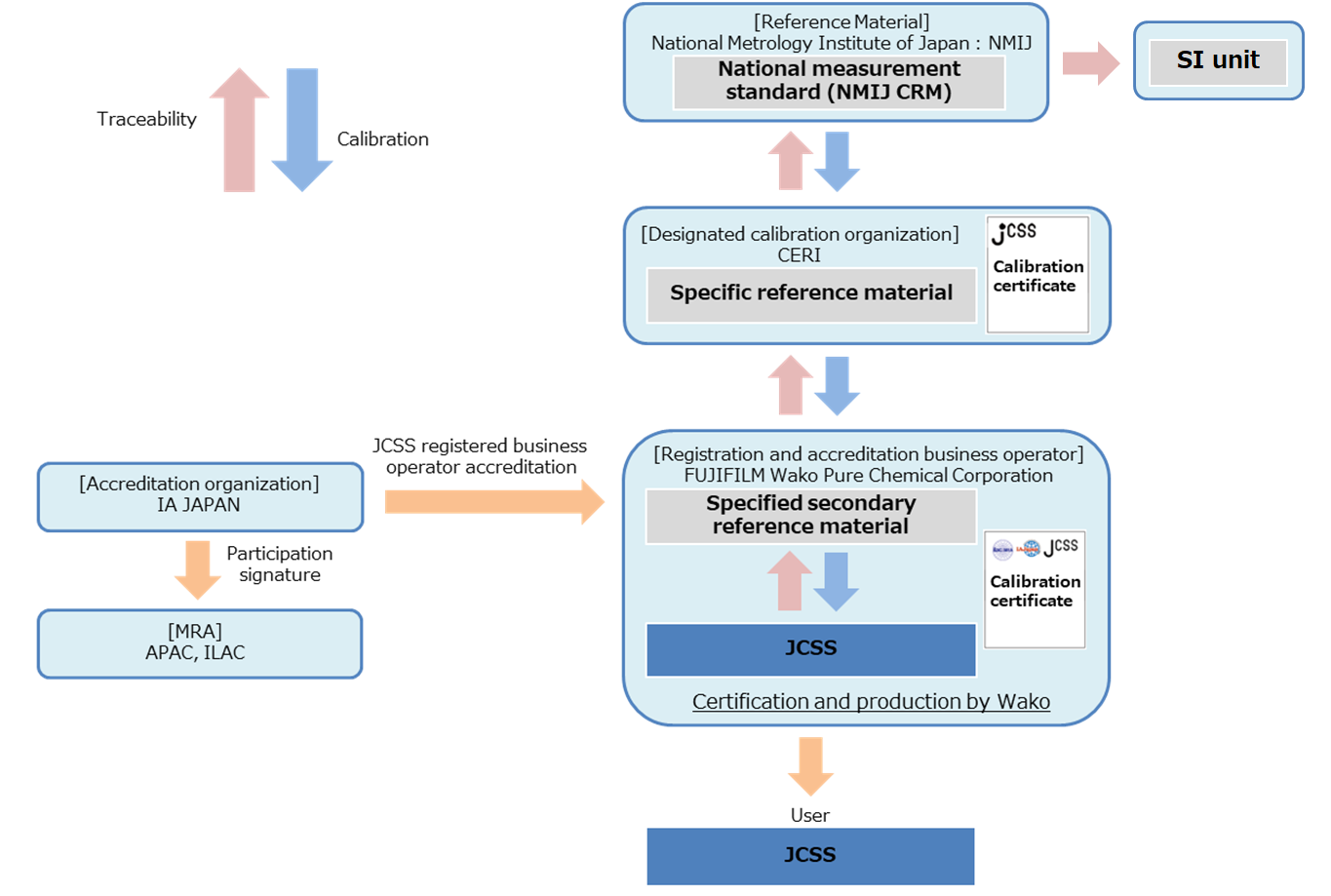
Measurement Method of Stinking Substances
In Japan, 22 stinking substances have been designated by the Environment Agency, and all factories within the regulated area designated by the each local government are required to measure stinking substances to considerate of the surrounding environment.
| No. | Stinking Substances | Regulation Value [ppm] | Analytical Method |
|---|---|---|---|
| 1 | Ammonia | 1-5 | Absorption Spectrophotometry |
| 2 | Methyl Mercaptan | 0.02-0.01 | GC |
| 3 | Hydrogen Sulfide | 0.02-0.2 | |
| 4 | Dimethyl Sulfide | 0.01-0.2 | |
| 5 | Dimethyl Disulfide | 0.009-0.1 | |
| 6 | Trimethylamine | 0.005-0.07 | GC |
| 7 | Acetaldehyde | 0.05-0.5 | GC, GC/MS, HPLC |
| 8 | Propionaldehyde | 0.05-0.5 | |
| 9 | n-butyraldehyde | 0.009-0.08 | |
| 10 | Isobutyraldehyde | 0.02-0.2 | |
| 11 | n-valeraldehyde | 0.009-0.05 | |
| 12 | Isovaleraldehyde | 0.003-0.01 | |
| 13 | Isobutanol | 0.9-20 | GC, GC/MS |
| 14 | Ethyl Acetate | 3-20 | |
| 15 | Methyl Isobutyl Ketone | 1-6 | |
| 16 | Toluene | 10-60 | |
| 17 | Styrene | 0.4-2 | |
| 18 | Xylene | 1-5 | |
| 19 | Propionic Acid | 0.03-0.2 | GC |
| 20 | n-Butyric Acid | 0.001- 0.006 | |
| 21 | n-Valeric Acid | 0.0009-0.004 | |
| 22 | Isovaleric Acid | 0.001-0.01 |
Composition List (Aldehyde Mixture)
| Constituent | 2 Aldehydes | 6 Aldehydes | 16 Aldehydes | |
|---|---|---|---|---|
| 012-17391 018-17491 |
012-15451 | 012-14851 019-27811 |
018-18231 | |
| Formaldehyde | 〇 | 〇 | 〇 | |
| Acetaldehyde | 〇 | 〇 | 〇 | 〇 |
| Propionaldehyde | 〇 | 〇 | 〇 | |
| Acrolein | 〇 | |||
| Acetone | 〇 | |||
| n-Butyraldehyde | 〇 | 〇 | ||
| Isobutyraldehyde | 〇 | 〇 | 〇 | |
| Crotonaldehyde | 〇 | |||
| n-Valeraldehyde | 〇 | 〇 | 〇 | |
| Isovaleraldehyde | 〇 | 〇 | 〇 | |
| Benzaldehyde | 〇 | |||
| n-Hexanal | 〇 | |||
| o-Tolualdehyde | 〇 | |||
| m-Tolualdehyde | 〇 | |||
| p-Tolualdehyde | 〇 | |||
| 2,5-Dimethylbenzaldehyde | 〇 | |||
HPLC Column (Wakopak® Wakosil-DNPH)
Wakopak® Wakosil DNPH specializes in the analysis of aldehydes. This column can simultaneous analyze iso-, n-butyraldehyde (difficult-to-separate) and other aldehydes. In addition, by using the Wakosil® DNPH Eluent, it is possible to suppress baseline fluctuations and elution of unknown peaks.
HPLC Chromatogram
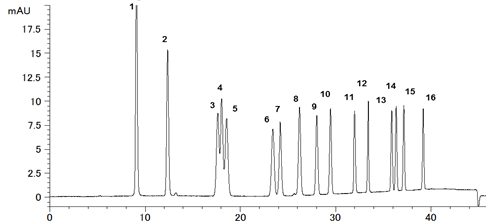
-
1. Formaldehyde-2,4-DNPH
2. Acetaldehyde-2,4-DNPH
3. Propionaldehyde-2,4-DNPH
4. Acrolein-2,4-DNPH
5. Acetone-2,4-DNPH
6. Isobutyraldehyde-2,4-DNPH
7. n-Butyraldehyde-2,4-DNPH
8. Crotonaldehyde-2,4-DNPH9. Isovaleraldehyde-2,4-DNPH
10. n-Valeraldehyde-2,4-DNPH
11. Benzaldehyde-2,4-DNPH
12. Hexaldehyde-2,4-DNPH
13. o-Tolualdehyde-2,4-DNPH
14. m-Tolualdehyde-2,4-DNPH
15. p-Tolualdehyde-2,4-DNPH
16. 2,5-Dimethylbenzaldehyde-2,4-DNPH
Analysis Condition
| Column | Wakopak® Wakosil-DNPH (4.6mmφ x 250mm) | ||||||||
| Eluent | A) Wakosil®-DNPH Eluent A B) Wakosil®-DNPH Eluent B |
||||||||
| Gradient |
|
||||||||
| Flow Rate | 0.8mL/min. at 35℃ | ||||||||
| Inj. Vol. | 10μL | ||||||||
| Detector | UV 360nm |
SPE Column (Presep®-C DNPH)
Presep® DNPH is a SPE column which collects aldehydes and derivatives them with 2,4-dinitrophenylhydrazine (DNPH).
This column can reduce noise for lower aldehyde (formaldehyde, acetaldehyde, and acetone).
HPLC Chromatogram
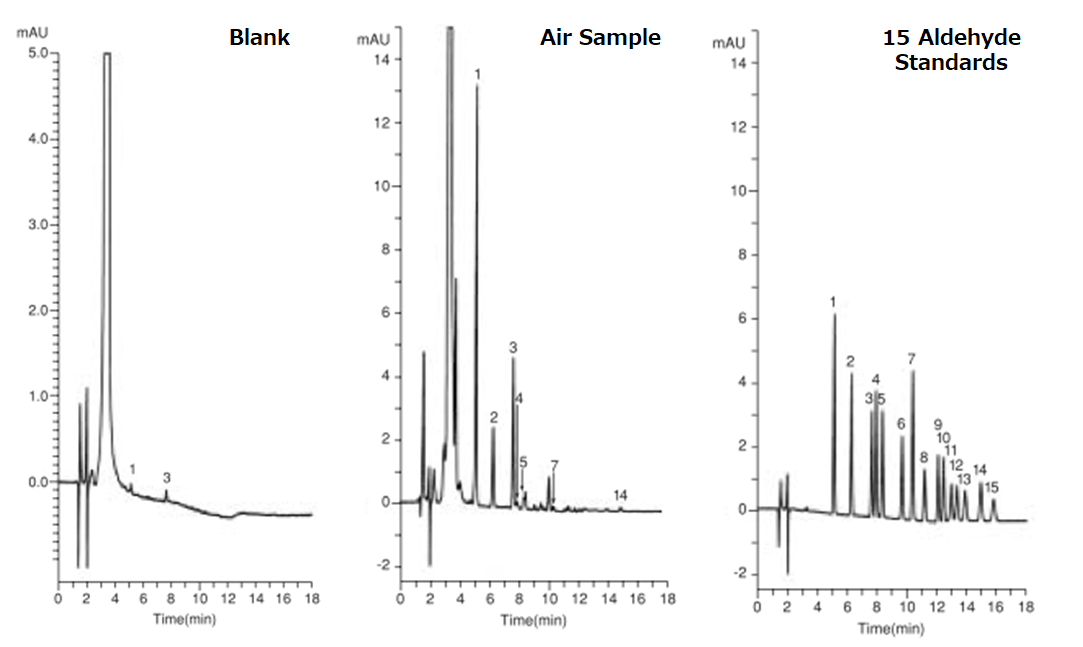
-
1. Formaldehyde-2,4-DNPH
2. Acetaldehyde-2,4-DNPH
3. Acetone-2,4-DNPH
4. Acrolein-2,4-DNPH
5. Propionaldehyde-2,4-DNPH
6. Crotonaldehyde-2,4-DNPH
7. n-,Isobutyraldehyde-2,4-DNPH
8. Benzaldehyde-2,4-DNPH9. Isovaleraldehyde-2,4-DNPH
10. n-Valeraldehyde-2,4-DNPH
11. o-Tolualdehyde-2,4-DNPH
12. m-Tolualdehyde-2,4-DNPH
13. p-Tolualdehyde-2,4-DNPH
14. Hexaldehyde-2,4-DNPH
15. 2,5-dimethylbenzaldehyde-2,4-DNPH
Analysis Condition
| Column | Wakopak® Wakosil-DNPH-Ⅱ (4.6mmφ x 150mm) | ||||||||
| Eluent | A) Wakosil®-DNPH-Ⅱ Elunt A B) Wakosil®-DNPH-Ⅱ Elunt B |
||||||||
| Gradient |
|
||||||||
| Flow Rate | 1.0mL/min. at 35℃ | ||||||||
| Inj. Vol. | 10μL | ||||||||
| Detector | UV 360nm |
Product List
- Open All
- Close All
VOC Mixture Standard Solution
Aldehyde Mixture Standard Solution
Stinking Substances Standard Solution
HPLC Column
SPE Column
Eluent
For research use or further manufacturing use only. Not for use in diagnostic procedures.
Product content may differ from the actual image due to minor specification changes etc.
If the revision of product standards and packaging standards has been made, there is a case where the actual product specifications and images are different.




